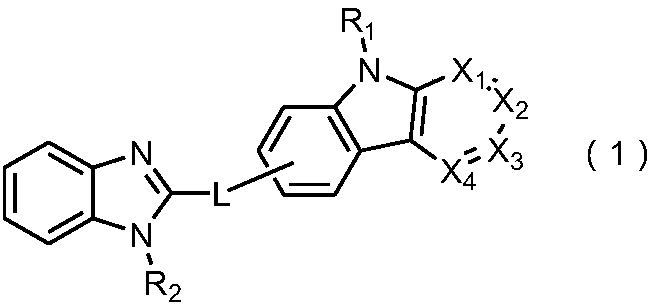Organic light emitting device
A technology of organic light-emitting devices and light-emitting layers, which is applied in the fields of electrical solid-state devices, semiconductor devices, semiconductor/solid-state device manufacturing, etc., and can solve problems such as low recombination efficiency of electrons and holes, device failure, and unbalanced carrier injection
- Summary
- Abstract
- Description
- Claims
- Application Information
AI Technical Summary
Problems solved by technology
Method used
Image
Examples
Embodiment 1
[0107] Embodiment 1: the synthesis of compound 1-A1
[0108]
[0109] Synthesis of Intermediate A1-1
[0110] To 7-bromo-5H - A solution of pyrido[4,3-B]indole (45.2 g, 183 mmol) and iodobenzene (37.7 g, 185 mmol) in degassed toluene (1 L), and the mixture was heated at reflux for 2 hours. The reaction mixture was cooled to room temperature, diluted with toluene and filtered through celite. The filtrate was diluted with water and extracted with toluene, and the combined organic phases were evaporated under vacuum. The residue was filtered through silica gel and recrystallized. Intermediate A1-1 (47.2 g, 80% yield) was obtained.
[0111] Mass Spectrum m / z: 323.23 (calculated: 323.19). Theoretical element content (%)C 17 h 11 N 2 Br: C, 63.18; H, 3.43; Br, 24.72; N, 8.67 Measured element content (%): C, 63.19; H, 3.45; Br, 24.72; N, 8.64. The above results confirmed that the obtained product was the target product.
[0112] Synthesis of Intermediate B1-1
[0113] T...
Embodiment 2
[0121] Embodiment 2: the synthesis of compound 1-B2
[0122]
[0123] Synthesis of Intermediate A1-1
[0124] To 7-bromo-5H - A solution of pyrido[4,3-B]indole (45.2 g, 183 mmol) and iodobenzene (37.7 g, 185 mmol) in degassed toluene (1 L), and the mixture was heated at reflux for 2 hours. The reaction mixture was cooled to room temperature, diluted with toluene and filtered through celite. The filtrate was diluted with water and extracted with toluene, and the combined organic phases were evaporated under vacuum. The residue was filtered through silica gel and recrystallized. Intermediate A1-1 (47.2 g, 80% yield) was obtained.
[0125] Mass Spectrum m / z: 323.23 (calculated: 323.19). Theoretical element content (%)C 17 h 11 N 2 Br: C, 63.18; H, 3.43; Br, 24.72; N, 8.67 Measured element content (%): C, 63.19; H, 3.45; Br, 24.72; N, 8.64. The above results confirmed that the obtained product was the target product.
[0126] Synthesis of Intermediate B2-1
[0127] T...
Embodiment 3
[0135] Embodiment 3: the synthesis of compound 2-A1
[0136]
[0137] Synthesis of intermediate a1-1
[0138] Take 3,5-dichlorobiphenyl (9.4g, 42.4mmol) into a three-necked flask, add 100mL of THF, protect it under nitrogen, stir at -78°C for 30 minutes, then add 21mL of n-butyllithium (2.5M), and react 1 After 1 hour, add 14 g of triisopropyl borate, react at low temperature for 1 hour, and gradually return to room temperature. In the post-treatment process, 2M hydrochloric acid was added to the system to make the pH of the solution 4-5, and the liquid separation was allowed to stand. The aqueous layer was extracted with ethyl acetate, the organic layers were combined, and spin-dried to obtain intermediate a1-1 (8.2g, yield 80%).
[0139] Mass Spectrum m / z: 242.16 (calculated: 242.09). Theoretical element content (%) C12H12B2O4: C, 59.60; H, 5.00; B, 8.94; O, 26.46 Measured element content (%): C, 59.61; H, 5.02; B, 8.94; O, 26.43. The above results confirmed that the ...
PUM
 Login to View More
Login to View More Abstract
Description
Claims
Application Information
 Login to View More
Login to View More - R&D
- Intellectual Property
- Life Sciences
- Materials
- Tech Scout
- Unparalleled Data Quality
- Higher Quality Content
- 60% Fewer Hallucinations
Browse by: Latest US Patents, China's latest patents, Technical Efficacy Thesaurus, Application Domain, Technology Topic, Popular Technical Reports.
© 2025 PatSnap. All rights reserved.Legal|Privacy policy|Modern Slavery Act Transparency Statement|Sitemap|About US| Contact US: help@patsnap.com



